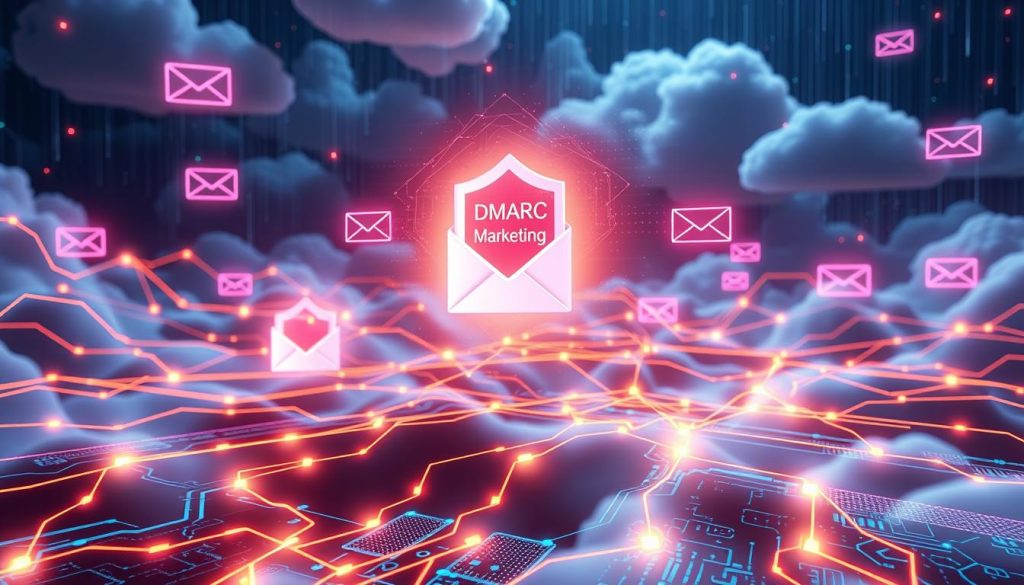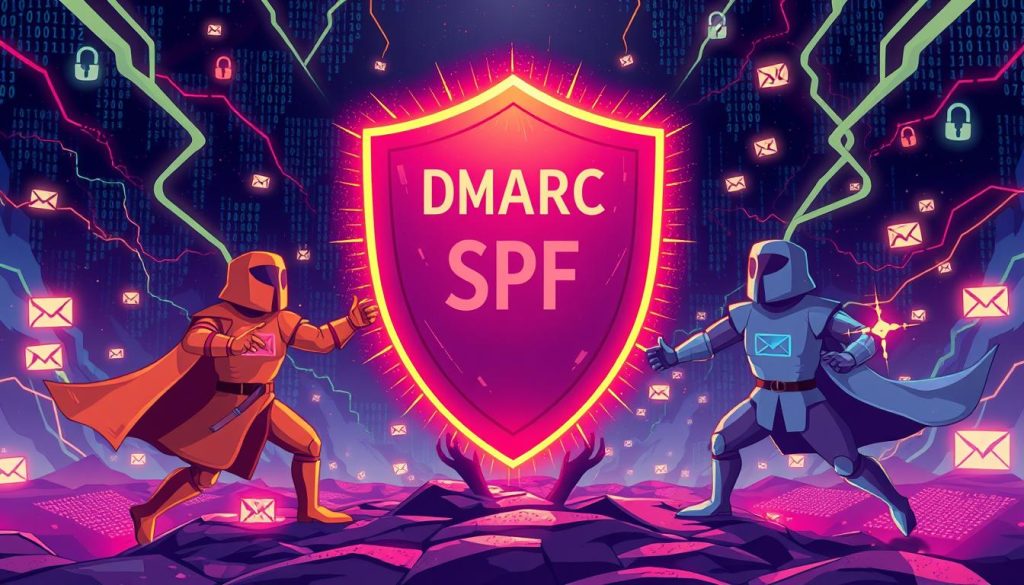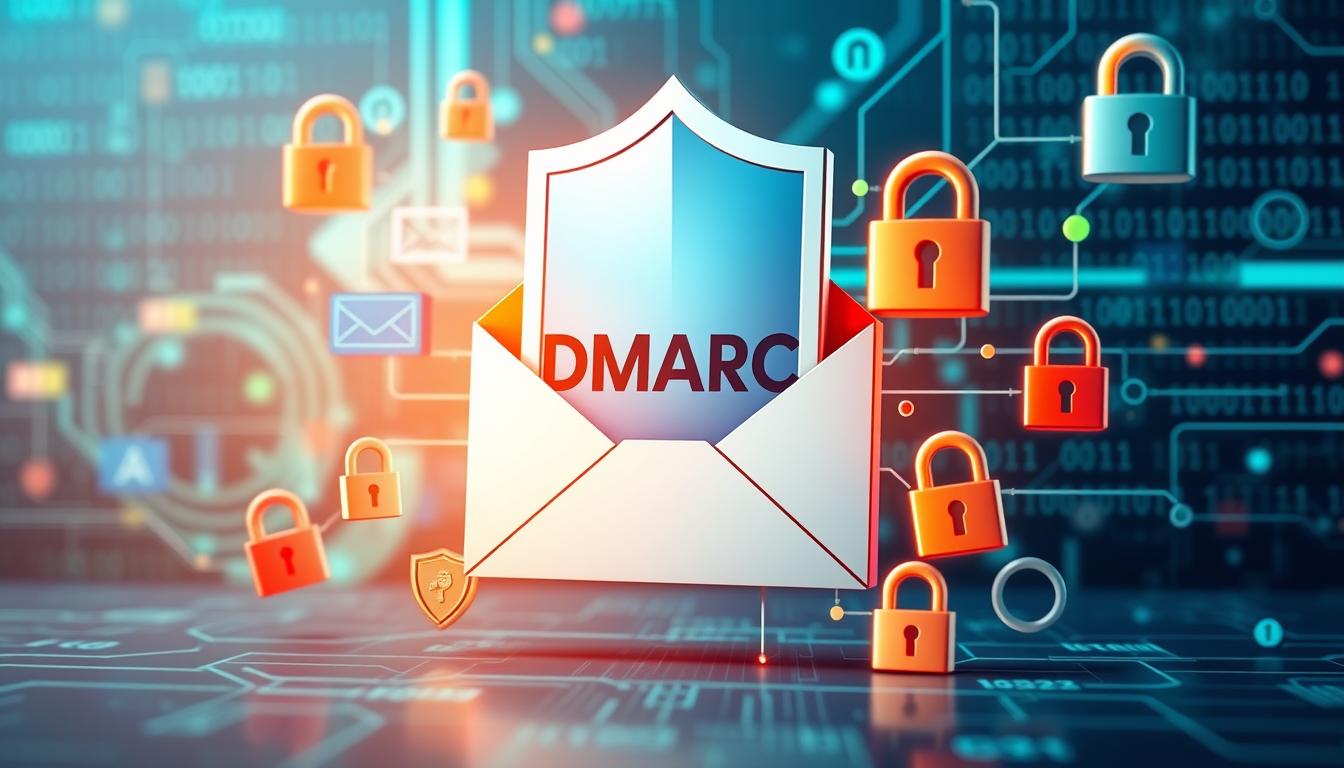Email is still a key way for businesses to reach their audience. But, threats like email spoofing and phishing are always there. They can harm your brand’s image and make your customers doubt you. This guide will show how DMARC helps keep your cold email campaigns safe.
DMARC is a key tool for keeping your emails secure. It stops fake emails from looking like they’re from you. By using DMARC, you make your cold emails safer, get them delivered better, and keep your reputation strong. These are all important for your cold email marketing to do well.
Key Takeaways
- DMARC is a crucial email authentication protocol that protects your brand from email spoofing and phishing attacks.
- Implementing DMARC can significantly improve the deliverability and sender reputation of your cold email campaigns.
- DMARC works in conjunction with other email authentication standards, such as SPF and DKIM, to provide a comprehensive security solution.
- Understanding and implementing DMARC is essential for businesses that rely heavily on email marketing, including cold email outreach.
- Overcoming common DMARC implementation challenges, such as legacy systems and third-party services, is crucial for maximizing the benefits of DMARC.
What is DMARC and Why Does It Matter?
DMARC stands for Domain-based Message Authentication, Reporting, and Conformance. It’s a key email security tool that fights against email spoofing and phishing. It checks if emails are really from your domain, keeping your brand safe and stopping scams.
Understanding Domain-based Message Authentication, Reporting, and Conformance
DMARC is built on SPF and DKIM to offer strong email security. It checks who sent an email and lets domain owners decide what to do if it’s not legit.
The Risks of Email Spoofing and Phishing Attacks
- Email spoofing means sending fake emails to look like they’re from someone else, often to trick people.
- Phishing attacks use fake emails to get sensitive info or make you click on bad links.
- These scams can cause big problems, like losing money, hurting your reputation, and leading to more cybercrime.
Using DMARC helps stop these threats. It keeps your brand, customers, and profits safe from harm.
The Importance of DMARC in Protecting Your Cold Email Campaigns
Running successful cold email campaigns is key for many businesses. But, cybercriminals often target these efforts. They try to fake your brand’s identity by sending fake emails that look like they’re from you. This can harm your reputation, lower email delivery rates, and cause financial losses from phishing.
DMARC (Domain-based Message Authentication, Reporting, and Conformance) is a powerful tool against these threats. It helps protect your cold email campaigns and keeps your brand safe. With DMARC, you can stop domain spoofing. This ensures your real emails get to the right people, while blocking fake ones that pretend to be from you.
DMARC aligns your domain’s email checks, like SPF and DKIM, to confirm messages are real. This boosts your email security and helps keep your sender reputation strong. A good reputation is key for getting your emails delivered to the right inbox.
Using DMARC for your cold email campaigns is a smart investment in their success. It builds trust with your audience and shows you’re serious about email security. This can lead to more of your emails being opened and acted upon, helping your business grow.
“DMARC is a critical tool in the fight against email spoofing and phishing attacks. Implementing it can significantly enhance the security and deliverability of your cold email campaigns.”
Next, we’ll explore DMARC’s technical details, how to set it up, and its role in your email marketing strategy. Keep reading to learn how DMARC can protect your cold email campaigns.
Email Authentication and Deliverability
Getting your cold emails delivered is key to your email marketing success. This is where email authentication protocols, like DMARC, play a big role.
How DMARC Improves Email Deliverability
DMARC (Domain-based Message Authentication, Reporting, and Conformance) boosts email deliverability. It works with SPF and DKIM to make sure your emails are real. This reduces the chance of your emails being seen as spam and improves your sender reputation.
DMARC helps in several ways:
- It stops email spoofing by checking the sender’s domain and email address.
- It makes email authentication stronger by using SPF and DKIM.
- It gives detailed reports on email authentication and delivery. This lets you spot and fix any problems.
- It builds trust with recipients. DMARC-authenticated emails are less likely to be marked as spam or phishing.
By using a strong email authentication strategy, including DMARC, you can make your cold email campaigns more successful. This improves your overall email marketing best practices.
“DMARC is a game-changer for email deliverability, helping businesses like ours enhance our sender reputation and ensure our messages reach the right inboxes.”
Protecting Your Sender Reputation
In the fast-paced world of cold email marketing, keeping a strong sender reputation is key. Email security and email authentication are vital. DMARC (Domain-based Message Authentication, Reporting, and Conformance) is crucial for protecting your domain and brand.
DMARC helps fight email spoofing and phishing. These attacks can harm your sender reputation. By using DMARC, you show email providers and recipients that you’re serious about sending genuine emails.
With DMARC set up right, you can:
- Stop unauthorized use of your domain in phishing or spoofing
- Boost email deliverability by improving email security and email authentication
- Strengthen your email marketing best practices and gain trust with your audience
Using DMARC in your email security plan is a big step. It helps protect your sender reputation and builds a trustworthy brand online.
| Key Benefits of DMARC for Sender Reputation | Description |
|---|---|
| Fraud Prevention | DMARC stops unauthorized use of your domain in phishing or spoofing attacks, protecting your brand’s reputation. |
| Email Deliverability | By improving email security and authentication, DMARC can boost your email deliverability and engagement rates. |
| Trust and Credibility | DMARC shows your dedication to email security, building trust and credibility with your target audience. |
Implementing DMARC: A Step-by-Step Guide
Implementing DMARC is key to protecting your cold email campaigns. It stops spoofing and phishing attacks. By setting up DMARC records and checking reports, you boost email security and delivery. This keeps your sender reputation safe.
Setting Up DMARC Records
The first step is to create DMARC records for your domain. You need to define your DMARC policy. It can be none, quarantine, or reject. Start with none to see how DMARC affects your emails before moving to a stricter policy.
- Choose your DMARC policy based on your business needs and email practices.
- Make the DMARC record and add it to your domain’s DNS settings.
- Make sure your SPF and DKIM records match your DMARC policy.
Monitoring and Interpreting DMARC Reports
After setting up DMARC, you’ll get regular reports on your domain’s email traffic. These reports help you see how well DMARC is working. They also show any problems that need fixing.
- Regularly check and understand the DMARC reports.
- Find any unauthorized senders or failed email checks.
- Change your DMARC policy or email checks based on the report insights.
By following these steps and keeping an eye on your DMARC, you can make your email security strong. This protects your cold email campaigns from harmful attacks.
DMARC and Email Marketing Best Practices
As an email marketer, keeping your campaigns secure and delivered is key. DMARC, or Domain-based Message Authentication, Reporting, and Conformance, is a big help. It makes your email marketing better and more effective.
DMARC protects your brand from fake emails and phishing. It builds trust with your readers and makes your emails more likely to get through. This means more people will see and engage with your messages.
Enhancing Email Deliverability with DMARC
DMARC makes your emails more likely to arrive in your readers’ inboxes. By setting up DMARC records, your emails are seen as real by ISPs and ESPs. This stops your emails from being marked as spam or bounced.
Building Trust and Protecting Your Sender Reputation
DMARC also keeps your sender reputation safe. It stops fake emails from looking like they’re from you. This keeps your brand’s trust and credibility with your readers.
To get the most from DMARC, use it with your best email marketing practices. This means making your emails better, segmenting your lists, and watching how your emails do. This way, you’ll get the best results from your email campaigns.
| DMARC Best Practices | Email Marketing Best Practices |
|---|---|
|
|
Using DMARC with your email marketing best practices makes your campaigns more secure and effective. This approach builds trust, protects your brand, and boosts your email marketing results.

“DMARC is a critical component of any modern email marketing strategy. It not only enhances the security of your campaigns but also improves deliverability and builds trust with your subscribers.”
Overcoming Common DMARC Implementation Challenges
Setting up DMARC, a key email security tool, can be tough for many companies. This is especially true for those with old systems and many third-party services. But, by knowing and tackling these common issues, you can make your DMARC setup smooth and strong. This will help protect your email campaigns from threats.
Handling Legacy Systems and Third-Party Services
One big challenge is making DMARC work with your current email setup, especially old systems. Working with third-party services, like email marketing tools or cloud services, can also be tricky.
To get past these problems, start by checking your email setup thoroughly. Find out which systems and services you use. Talk to your third-party providers to see if they’re ready for DMARC. Work together to make sure everything works well together.
Getting help from DMARC experts can be very helpful. They know how to deal with old systems and third-party services. They can guide you on the best steps, help plan your rollout, and make sure it fits with your email security plans.
| Challenge | Strategy |
|---|---|
| Legacy Email Systems | Conduct a comprehensive audit, identify compatibility issues, and develop a plan for gradual migration or integration. |
| Third-Party Service Providers | Engage with providers, understand their DMARC readiness, and collaborate on a seamless integration plan. |
By tackling these DMARC setup challenges head-on, companies can keep their email safe for the long term. This helps protect their brand from email scams and phishing.
DMARC vs. SPF and DKIM
Email security is now a big deal for businesses and people. DMARC, SPF, and DKIM are key email security tools. They help make your emails safer and more reliable.
Understanding the Differences and Complementary Roles
Each tool has its own job but they work together well. Here’s how:
- SPF – Helps stop fake emails by saying who can send emails for you.
- DKIM – Signs emails to prove who sent them, keeping messages safe.
- DMARC – Uses SPF and DKIM to tell email servers what to do with fake emails, keeping your emails safe.
Using these email authentication protocols makes your cold email campaigns more secure. It also helps your emails get to the right people. This keeps your brand safe and builds trust with your audience.

“DMARC, SPF, and DKIM work together to create a powerful defense against email spoofing and phishing attacks, strengthening the security and reputation of your email communications.”
The Future of Email Security: Beyond DMARC
The digital world is always changing, and so is email security. Experts say we’ll see new ways to protect emails, using things like artificial intelligence (AI) and machine learning (ML). These changes will shape how we keep emails safe in the future.
New email security standards might come soon, building on what DMARC has started. These could fight off phishing and other threats better. This means emails will be safer, and so will the way we send them.
AI and ML will also be big in email security. They can spot unusual emails and find threats before they hit us. This makes email security smarter and more ready for new dangers.
| Emerging Email Security Trends | Potential Impact |
|---|---|
| Advanced Email Authentication Protocols | Enhanced protection against phishing, spoofing, and other email-based threats |
| AI and ML-powered Email Security | Improved threat detection, analysis, and response capabilities |
| Integrated Email Deliverability Solutions | Seamless optimization of email deliverability and sender reputation |
As email security keeps getting better, businesses and marketers need to keep up. Knowing about these new trends and looking into options beyond DMARC is key. This way, cold email campaigns can stay safe, effective, and in line with the latest in email security.
“The future of email security is not just about protecting against threats, but about empowering businesses to leverage email as a strategic tool for growth and success.”
Case Studies: DMARC Success Stories
DMARC (Domain-based Message Authentication, Reporting, and Conformance) has changed the game for email security. We’ll look at real cases where DMARC made a big difference.
A top e-commerce site was hit hard by phishing attacks. They used DMARC to quickly stop these threats. This move saved their brand and customer trust. They saw a big drop in fraud and better email delivery.
A big bank also faced email security issues. DMARC helped them boost their email checks. This kept their customers safe from fake emails. It also made their email marketing more reliable.
| Company | Industry | DMARC Benefits |
|---|---|---|
| E-commerce Retailer | Retail |
|
| Financial Institution | Finance |
|
These stories show how DMARC can help. They offer lessons for keeping email campaigns safe. This way, businesses can protect their reputation and build trust with customers.
“DMARC has been a game-changer for our organization, helping us regain control over our email domain and protect our customers from the threat of phishing attacks.”
– Chief Information Security Officer, Leading E-commerce Retailer
Choosing the Right DMARC Solution
Starting your journey to secure cold email campaigns means picking the right DMARC solution. DMARC service providers have different features and capabilities. It’s key to evaluate them well to find the best fit for your needs.
Evaluating DMARC Service Providers
When looking at DMARC service providers, think about ease of use, reporting, and support. Choose providers with easy-to-use interfaces and smooth integration with your email systems. Also, look for detailed reporting tools that give you insights into your email security.
It’s also important to find providers that offer help and guidance. Understanding DMARC well is crucial for its effective use. The right provider can help you through the process, making it easier and smoother.
FAQ
What is DMARC and why is it important?
DMARC stands for Domain-based Message Authentication, Reporting, and Conformance. It’s a protocol that protects your domain from phishing and spoofing attacks. It verifies emails sent from your domain, improving deliverability and protecting your brand.
How does DMARC prevent email spoofing and phishing?
DMARC authenticates email senders to ensure they’re legitimate. This stops domain spoofing, a tactic used in phishing. It prevents criminals from tricking people into sharing sensitive info.
How does DMARC improve email deliverability?
DMARC checks email authenticity, boosting your sender reputation. This makes it more likely for cold emails to reach inboxes, not spam folders.
What are the different DMARC policy levels, and how do they work?
DMARC has three policies: “none” for monitoring, “quarantine” for spam, and “reject” for blocking. Businesses start with “none” to watch emails, then switch to “quarantine” or “reject” to block unauthorized ones.
How do I set up DMARC records for my domain?
To set up DMARC, create a DNS TXT record for your domain. It should include your policy and reporting details. It’s best to work with a DMARC service or an email security expert for proper setup.
How do I interpret and act on DMARC reports?
DMARC reports detail emails sent from your domain, showing who’s authenticated and who’s not. These reports help identify unauthorized senders and improve your email security and deliverability.
How does DMARC work with other email authentication protocols like SPF and DKIM?
DMARC, SPF, and DKIM work together for email security. DMARC uses SPF and DKIM results to verify email legitimacy from your domain.
What are some common challenges in implementing DMARC, and how can they be overcome?
Integrating DMARC with old email systems and dealing with unauthorized senders can be tough. Working with your IT team and a DMARC expert can help overcome these challenges.
How can I evaluate and choose the right DMARC solution for my cold email campaigns?
Look at the DMARC solution’s ease of use, reporting, support, and email security expertise. Comparing different providers can help you find the best one for your needs.


